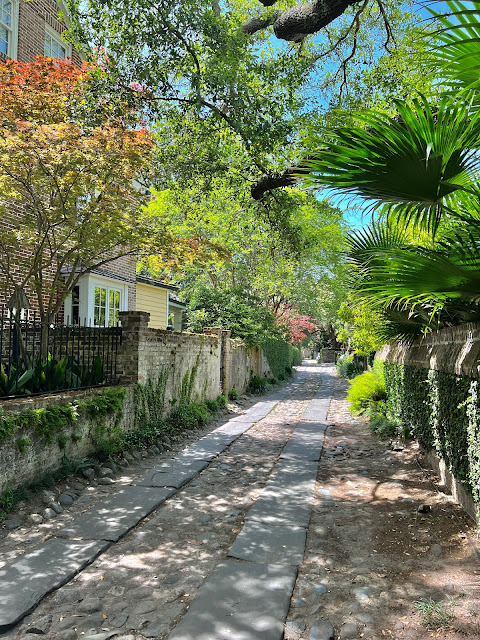Soon after leaving Savannah, we crossed the state line into the cradle of secession, the headquarters of treason in defense of slavery, the Palmetto State--South Carolina!
We were on our way to Charleston, but we planned a brief stopover in Hilton Head, best known of the Sea Islands.
Hilton Head is best known for its golf courses and beaches, but we were there to find out more about the Gullah/Geechee.
The Gullah people, also known as the Geechee, are African-Americans who live on the coast and the Sea Islands off South Carolina, Georgia, and Florida. Originally, they were brought as slaves from the rice-growing regions of West Africa, valued for their expertise with rice and their resistance to malaria and yellow fever. After the Civil War, the rice plantations collapsed, and the Gullah became farmers and fishers, mostly on lands that whites weren't interested in. Here, in virtual isolation, they developed a unique culture with specific African roots and their own language, a creole with many African loan words.
The Gullah language is one of the few creoles based on English rather than French. It's very similar to the creoles that developed in the British colonies of Bahamas, Barbados, and Belize.
We booked a Gullah Heritage tour, led by a Gullah man who grew up on Hilton Head Island, though he moved to Boston in his early twenties and became a teacher. He's now on the school board in Hilton Head as well as leading tours.
It wasn't the best tour ever, but it was interesting in its own way. I would have liked more about the Gullah culture, language, and history. Basically, we drove around the Gullah neighborhoods while he told us about his years growing up their and the people that he knew.
He didn't talk much about racial issues, but he did say that "'they' are fine with the Gullah culture, but 'they' don't like us owning things." Developers would love to get their hands on the land owned by Gullah families.
He also mentioned that "they" are trying to whitewash South Carolina's racist history out of the school curriculum. Can't have that commie CRT making little Jared and Madison feel uncomfortable.
After the tour, we drove into Charleston. It's a much bigger town than Savannah, with a very different vibe. We were a little put off at first, but we came to love it.
There are many beautiful old buildings.
Our hotel was a bit out of town, so we made the 15-minute commute for dinner at an excellent Italian restaurant, then zipped back up the freeway to sleep.
The next morning, I took the car in for an oil change and tire rotation. We're close to the halfway mark on this road trip as far as mileage is concerned, and we want to keep things humming.
We went to the James Beard award-winning BBQ of postmaster Rodney Scott for lunch. Superb smoked meat, but I have to say I like Texas-style sauce better than the vinegar-based Carolina style.
In the afternoon, we made a pilgrimage to the site where the Civil War began--Fort Sumter.
The museum where the tour begins has a conveniently vague explanation of the roots of the war. Slavery is mentioned, but only as one of several reasons for the conflict.
This whitewashing annoys me, and, as much as, I'm enjoying being here, it's not lost on either of us that most of the restaurants and tours and even the downtown streets are filled with white people, with the few blacks mostly, though not entirely, relegated to service positions.
That aside, the boat trip to Fort Sumter was a pleasure. Looking back at the Charleston skyline, I was struck by the total lack of high-rises. Part of its charm comes from its commitment to human scale.
This beautiful cable-stayed bridge over the Cooper river connects Charleston with Mt. Pleasant.
The carrier Yorktown, commissioned in 1943, is permanently docked here as a floating museum. One of the first movies I remember seeing was "The Fighting Lady," a 1944 Technicolor documentary filmed on the Yorktown and narrated by Robert Taylor. I was probably eight at the time, and it fed my lifelong fascination with WWII and the South Pacific.
I watched the film again last night on YouTube. It's very much of its time in terms of rah-rah propaganda and casual racism, but still a really interesting look at life on a carrier during that war. Check it out.
Fort Sumter sits on a manmade island in the center of the main approach to Charleston Harbor. It was the strategic key to this very strategic port.
The walls were virtually destroyed during the Civil War. They were once more than twice as high as they are now, which made the place a very formidable obstacle to anyone proposing to attack the harbor.
A replica of the 33-star flag that flew over the fort in 1861 waves in the stiff, cold wind. The red line on the pole marks the height of the fort's wall at that time.
And here's the actual flag itself.
One of the cannons that protected the fort.




































No comments:
Post a Comment